Best practices for safe transfer of common bean germplasm
Contributors to this page: CIAT, Colombia (Maritza Cuervo, Cesar Medina, Jose Luis Ramirez, Socorro Balcazar, Josefina Martinez, Daniel Debouck).
|
Flowchart 1.Germplasm management of Beans and Tropical Forages (Click to increase the size) |
The agreement between the CIAT and the International Treaty on Plant Genetic Resources for Food and Agriculture implies of the Genetic Resources Program (GRP) the conservation on behalf of the countries of 65,505 materials for 745 plant species of bean, cassava and tropical pastures as the biological patrimony of 141 countries. This responsibility of conservation is associated with the distribution of samples of this patrimony (517,916 samples distributed to 136 countries to the date) according to a regulation defined by the countries inside the Agreement, and phytosanitary procedure established by the Colombian Agricultural Institute.
The job of the GRP is to safeguard the genetic diversity of beans, cassava, forages, and their wild relatives through a mix of conservation methods, both in situ (in a natural outdoor habitat) and ex situ (in the controlled environment of a gene bank). Among the GRP's activities are research to improve conservation methods (including ways to minimize risks to the collections); screening germplasm for diseases and certifying it; duplicating materials of the collection; collecting or otherwise acquiring novel materials; recording passport, characterization and evaluation data for accessions of the collections (See Flowchart 1).
Phytosanitary risks are associated with international movement of germplasm, especially the inadvertent transport of pathogens and pests of quarantine significance. To minimize the phytosanitary risks associated with exchange germplasm and to ensure that it is free from pests and pathogens of quarantine significance; CIAT has implemented regulatory measures and safeguards to complement quarantine guidelines. The process, wich is supervised by the the Agricultural Colombian Institute (ICA), includes the following activities:
- Minimize the risk of accidental introduction of exotic pest and pathogens into Colombia;
- Inspect plant and facilities in screenhouses and grenhouses where the imported germplasm is being incresased;
- Inspect plants in fields and greenhouses where the germplasm intended for international export is produced; and
- Determine the seed health status of germplasm for international export.
The responsibility over the areas dealing with animal and plant health, with regard to international trade, has been bestowed upon the Agricultural Colombian Institute, within regulatory decree 1840 of 1994 “for which (ICA) has the mission of preventing the risk of the entry, spread, and establishment of exotic diseases, those of national sanitary concern, and of chemical risks, and protecting the sanitary quality of animals, plants and products that are exported, to minimize losses in animal-plant production and contribute to the security in foodstuffs”.
ICA has established quarantine procedures to regulate the introduction of plant germplasm and the issuing of phytosanitary certificates that accompany exports. ICA has a Plant Quarantine Station at an altitude of 2600 m (4o 42’ N latitude and 74o 12’W longitude) near Mosquera (Cundinamarca), about 15 km west of Santafé de Bogotá. ICA provides the regulatory mechanism for germplasm exchange following guidelines of the International Plant Protection Convention (IPPC). The recommendations of the IPPC were adopted by Colombian Congress in 1981 and implemented under decrees 501 of 1989.
In order to facilitate the importation and exportation, the ICA has developed the SISPAP, which may accessed through the ICA webpage in which the parties interested in importing and exporting plant products may become aware of the following via internet.
In Colombia, additional guidelines to reduce phytosanitary risks are in place. These safeguards are implemented according to the geographic origin and economic importance of the plant species concerned, and characteristic of potential pathogens and pests. Currently, ICA has a plant quarantine agreement with CIAT establishing which guidelines and safeguards are updated to facilitate germplasm exchange according to national and international requirements. An agreement was signed in 1981 between CIAT and ICA for quarantine procedures to regulate the introductions of germplasm into Colombia. The agreement permits the transit of seed through customs and quarantine stations according to the level of potential risk of introducing pests and diseases no yet reported in Colombia. High risk areas include Africa, Asia, and some European countries. The agreement covers not only crops for wich CIAT has a mandate but also other crops of economic importance to Colombia.
After clearance, materials pass through a step of multiplication in greenhouse stage, and the harvested seeds are subsequently planted in isolated fields. During these two steps, a phytosanitary follow-up is carried out. Plants showing any symptom of fungal, bacterial or viral disease are destroyed.
CIAT facilities for germplasm health testing are designed as a multifunctional laboratory to test seeds and tissues for fungi, bacteria, viruses, and occasionally nematodes and insects (See table below). The purpose of the Germplasm Health Laboratory (GHL) is to ensure that the designated germplasm is kept under the international phytosanitary standards for each crop commodity, and also to ensure that the germplasm distributed by GRP is free of diseases of quarantine importance (Listed in the table below)
The ICA Plant Quarantine Officer, stationed at CIAT, carries out field and greenhouses inspections and issues "ICA Phytosanitary Certificate" bases upon those inspections and results obtained by GHL. This document accompanies all out-going germplasm from Colombia (“decrees 1840 of 1994 articule 3”).
The germplasm leaving CIAT and the one used for exchange, conservation, and characterization in the GRP are multiplied in isolated fields under favorable ecological conditions with supervision by ICA quarantine officers. The GRP has seed multiplication sites in Popayan (Cauca) and Santander de Quilichao (Cauca). The harvested seeds are analyzed by GHL prior to shipment abroad or long-term conservation.
Seed health testing activities include:
- Reception, registration, sampling and storage of incoming material.
- Preparation of working samples for testing.
- Analysis.
The seed health testing methods used at CIAT for beans and tropical pastures are summarized in The Handbook of Procedures of the Germplasm Health Laboratory (2.7 MB) (see also Flows charts 2, 3, 4, 5 below, for a quick reference).
To detect pathogens of quarantine significance, the GHL uses the methodologies recommended by CIAT pathologists and virologists (see table below). When a recipient country has additional requirements, the GHL carries out additional tests wherever possible to comply with the specific quarantine regulations of the recipient country. The GHL realizes additional researches in the management and characterization of pathogens of quarantine importance and in the standardization of new methodologies of diagnosis that are more effective and sensitive.
Seed health testing methods applied at GHL to detect pathogens of quarantine significance for common bean and related species
|
Viruses |
Seed Health testing methods |
| Peanut Mottle Virus (PeMOV) | Indirect ELISA, kit for Potyvirus group |
| Bean common mosaic virus (BCMV) | Indirect ELISA, kit for Potyvirus group |
| Bean southern mosaic virus (BSMV) | DAS-ELISA |
| Bacteria | Seed Health testing methods |
|
|
Seedling symptom test, Dilution plating test, MXP and YDCA semiselective culture medium, serology test with commercial kit |
| Pseudomonas syringae pv. phaseolicola | Seedling symptom test, Dilution plating test, King B semiselective culture medium, serology test with commercial kit |
| Curtobacterium flaccumfasciens | Seedling symptom test, Dilution plating test, NBY semiselective culture medium, serology test with commercial kit |
| Pseudomonas fluorescens Biotipo II | Seedling symptom test, Dilution plating test, King B semiselective culture medium, serology test with commercial kit |
| Fungi | Seed Health testing methods |
| Alternaria spp. | Seedling symptom test, Blotter Test and direct visualization in Stereomicroscopy and Microscopy. |
| Ascochyta phaseolorum Sacc. Current name: Phoma exigua var. exigua Sacc. 1879 | Seedling symptom test, Blotter Test and direct visualization in Stereomicroscopy and Microscopy. |
| Botrytis cinerea Pers. (Teleomorph. Sclerotinia fuckeliana (de Bary) Fuckel) | Seedling symptom test, Blotter Test and direct visualization in Stereomicroscopy and Microscopy. |
| Cercospora canescens Ellis & G. Martin | Seedling symptom test, Blotter Test and direct visualization in Stereomicroscopy and Microscopy. |
| Colletotrichum gloeosporioides (Penz.) Penz. And Sacc. | Seedling symptom test, Blotter Test and direct visualization in Stereomicroscopy and Microscopy. |
| Colletotrichum lindemuthianum (anamorph.), Gloromella cingulata (teleomorph.) | Seedling symptom test, Blotter Test and direct visualization in Stereomicroscopy and Microscopy. |
| Colletotrichum truncatum (Schwein.) Andrus | Seedling symptom test, Blotter Test and direct visualization in Stereomicroscopy and Microscopy. |
| Fusarium oxysporum Schltdl. Y F. solani f. sp. solani | Seedling symptom test, Blotter Test and direct visualization in Stereomicroscopy and Microscopy. |
| Macrophomina phaseolina (Tassi) Goid | Seedling symptom test, Blotter Test and direct visualization in Stereomicroscopy and Microscopy. |
| Phoma exigua Desmaz. var. diversispora (Bubak) Boerema | Seedling symptom test, Blotter Test and direct visualization in Stereomicroscopy and Microscopy. |
| Phomopsis subcircinata (anamorph.), Diaporthe phaseolorum (teleomorph) | Seedling symptom test, Blotter Test and direct visualization in Stereomicroscopy and Microscopy. |
| Phaeoisariopsis griseola (Sacc.) Ferraris | Seedling symptom test, Blotter Test and direct visualization in Stereomicroscopy and Microscopy. |
| Rhizoctonia solani Kühn (Teleomorph Thanatephorus cucumeris (frank) Donk.) | Seedling symptom test, Blotter Test and direct visualization in Stereomicroscopy and Microscopy. |
| Sclerotinia sclerotiorum | Seedling symptom test, Blotter Test and direct visualization in Stereomicroscopy and Microscopy. |
| Sclerotium rolfsii Sacc. (Teleomrph. Corticium rolfsii Curzi) | Seedling symptom test, Blotter Test and direct visualization in Stereomicroscopy and Microscopy. |
| Insects | Seed Health testing methods |
| Acantoscelides sp. | Direct visual inspection |
| Zabrotes spp. | Direct visual inspection |
| Nematodes | Seed Health testing methods |
| Meloidogyne spp. | Washing sedimentation test, Visualization in Stereomicroscopy and Microscopy |
| Pratylenchus spp. | Washing sedimentation test, Visualization in Stereomicroscopy and Microscopy |
References and further reading
Cuervo MI, Balcazar MS, Ramirez JL, Medina CA, Debouck D. 2009. Manual de operaciones laboratorio sanidad de germoplasma – unidad de recursos genéticos. GRP, CIAT, Colômbia. 72 pp. Available in Spanish (2.8 MB) and English (2.6 MB).
Comments
- No comments found

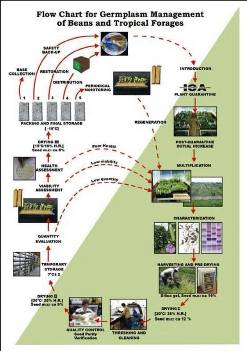
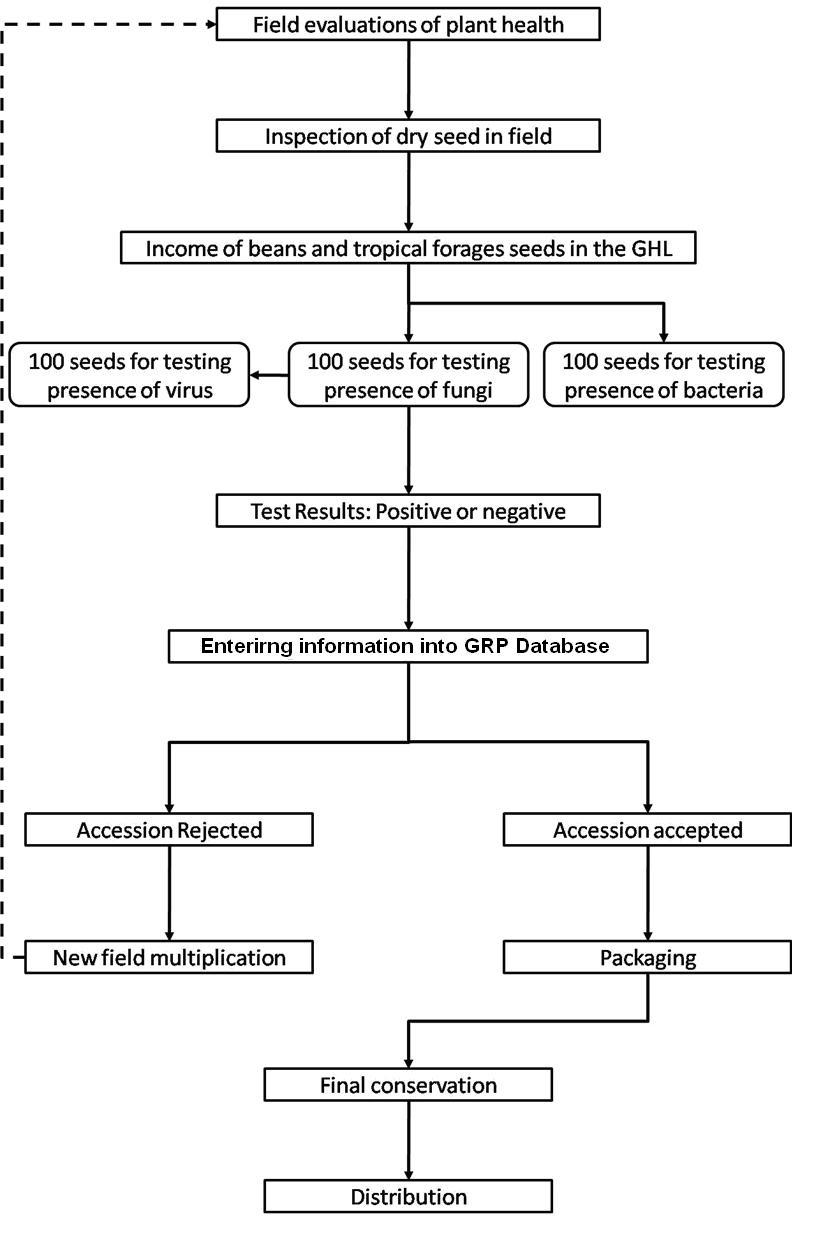
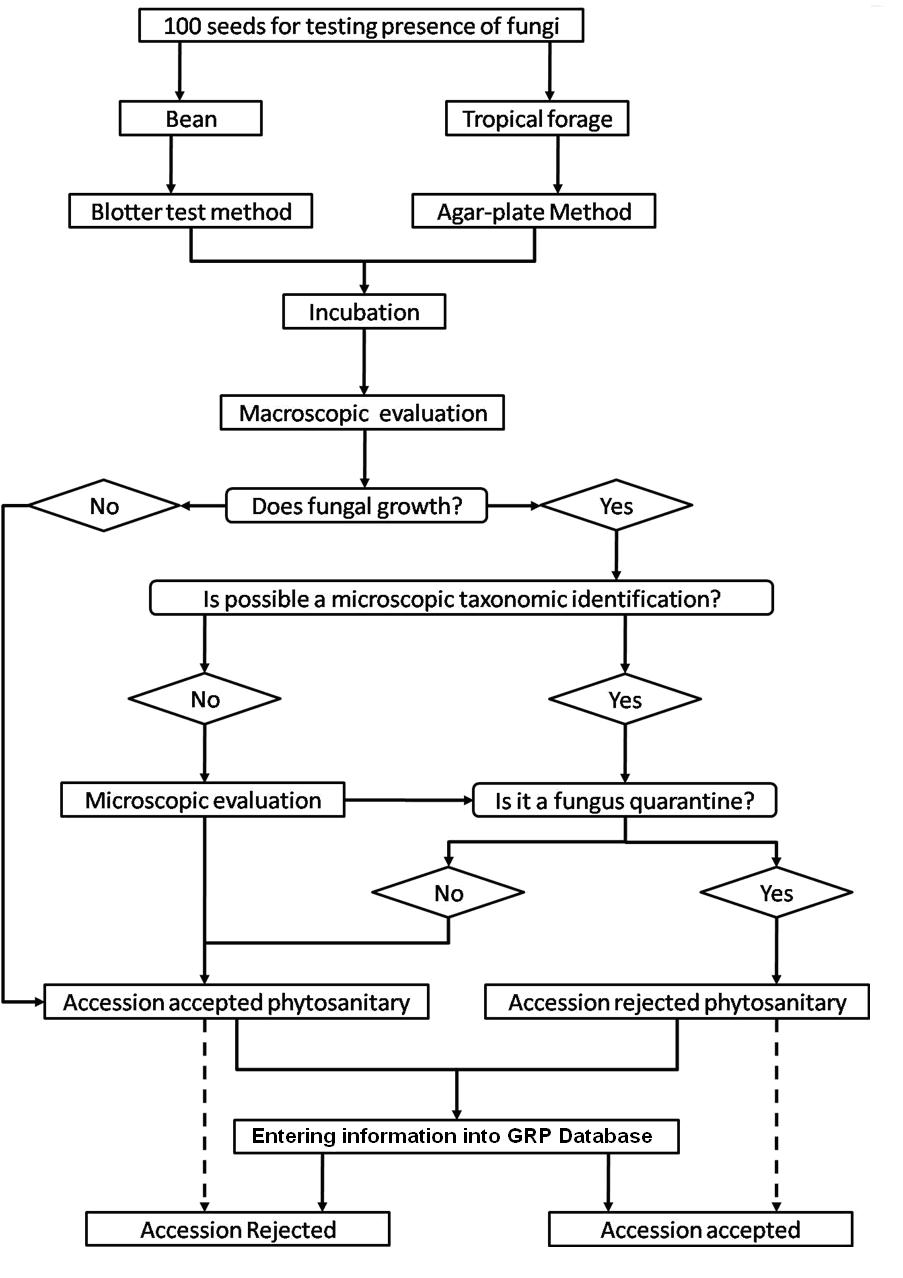
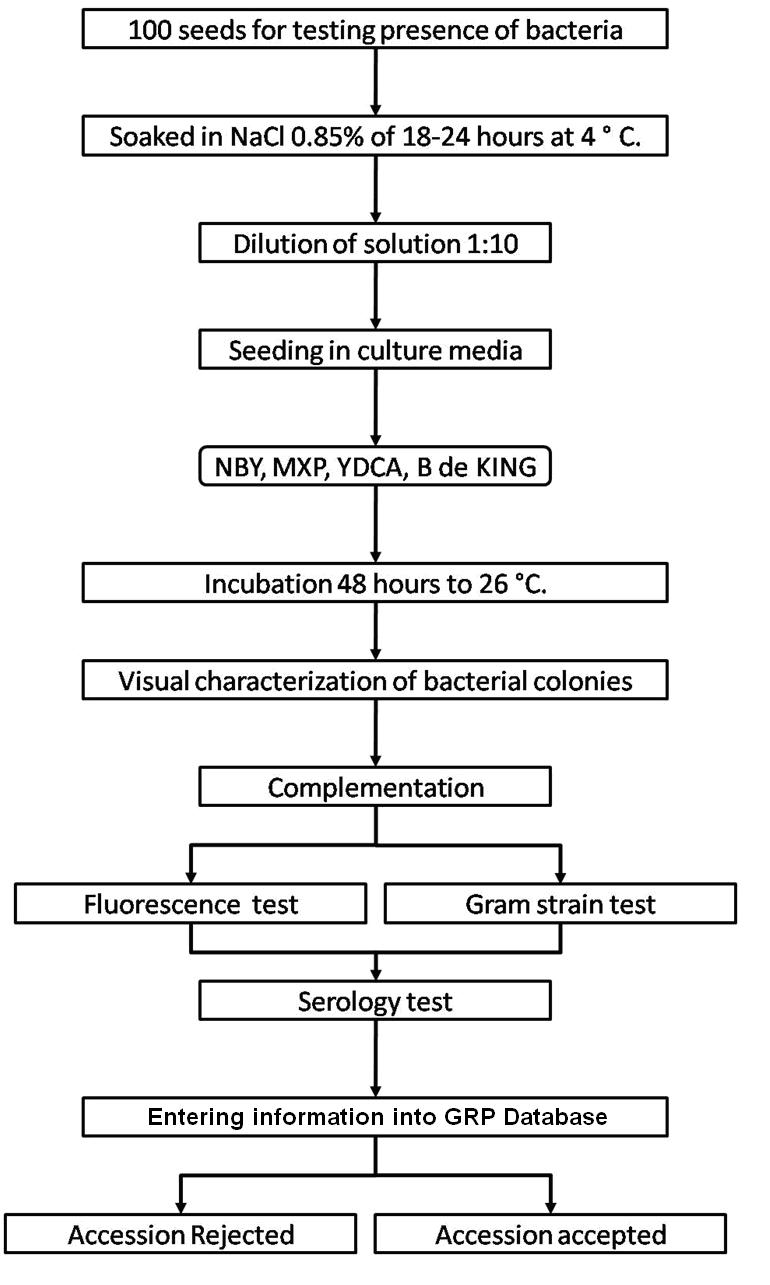
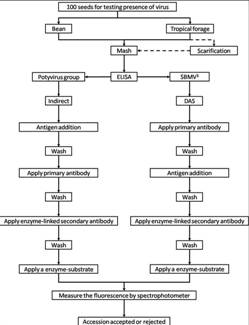
Leave your comments
Post comment as a guest